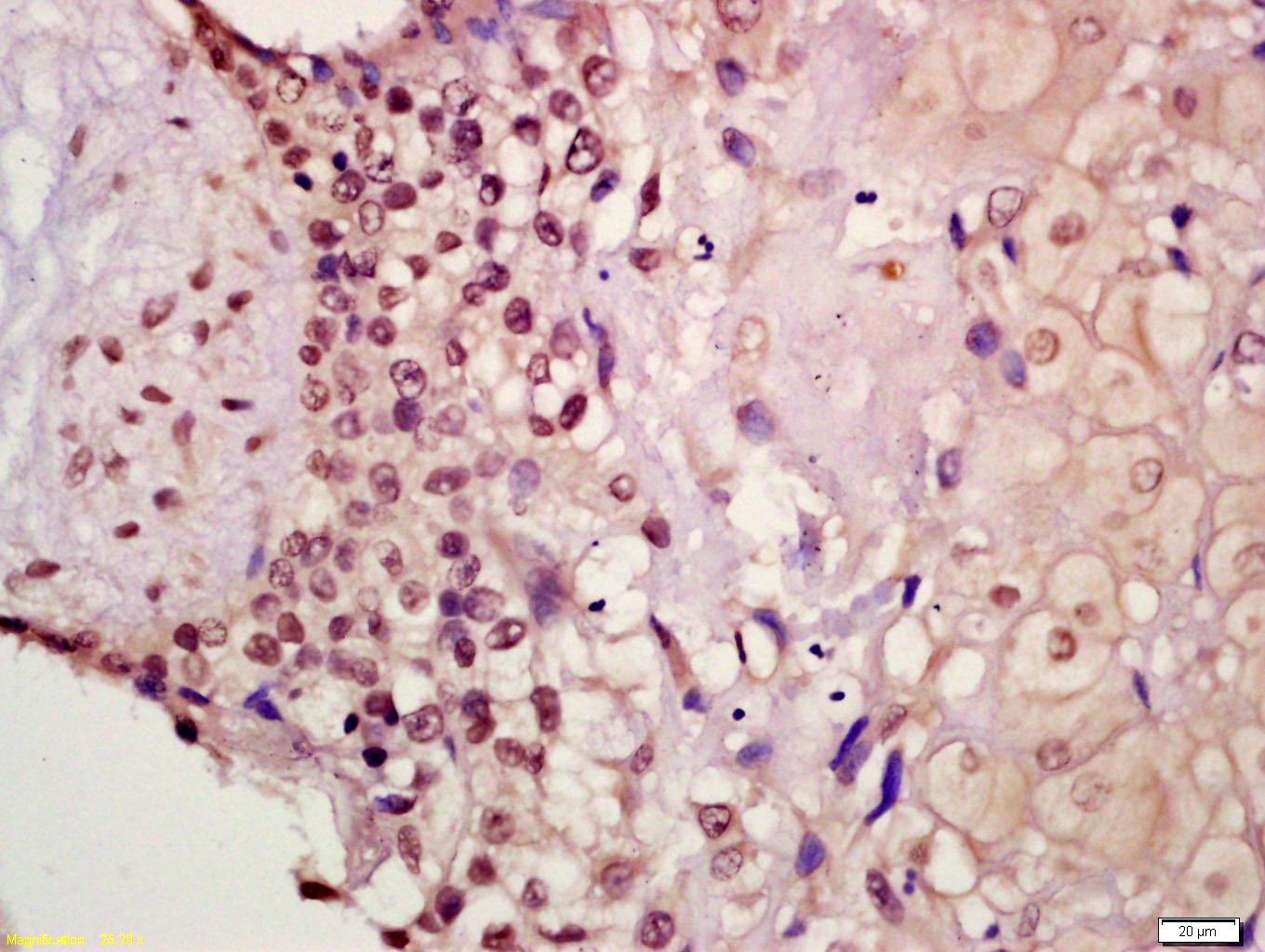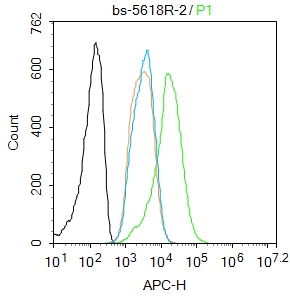
Rabbit Anti-Phospho-Smad2 (Thr220)antibody
Smad2 (phospho T220); p-Smad2 (phospho T220); phospho-Smad2(p-Thr220); p-Smad2(Thr220); phospho-Smad2(p-Thr220); hMAD 2; hSMAD2; JV18 1; JV18; JV181; MAD; MAD Related Protein 2; MADH2; MADR2; MGC22139; MGC34440; Mothers Against Decapentaplegic Homolog 2;
View History [Clear]
Details
Product Name Phospho-Smad2 (Thr220) Chinese Name 磷酸化细胞Signal transduction分子SMAD2抗体 Alias Smad2 (phospho T220); p-Smad2 (phospho T220); phospho-Smad2(p-Thr220); p-Smad2(Thr220); phospho-Smad2(p-Thr220); hMAD 2; hSMAD2; JV18 1; JV18; JV181; MAD; MAD Related Protein 2; MADH2; MADR2; MGC22139; MGC34440; Mothers Against Decapentaplegic Homolog 2; mothers against DPP homolog 2; SMAD 2; SMAD; SMAD2; SMAD2_HUMAN. literatures Product Type Phosphorylated anti Research Area Tumour immunology Signal transduction transcriptional regulatory factor Immunogen Species Rabbit Clonality Polyclonal React Species Human, (predicted: Mouse, Rat, Chicken, Dog, Cow, Horse, ) Applications ELISA=1:5000-10000 IHC-P=1:100-500 IHC-F=1:100-500 Flow-Cyt=2ug/Test IF=1:100-500 (Paraffin sections need antigen repair)
not yet tested in other applications.
optimal dilutions/concentrations should be determined by the end user.Theoretical molecular weight 52kDa Cellular localization The nucleus cytoplasmic Form Liquid Concentration 1mg/ml immunogen KLH conjugated Synthesised phosphopeptide derived from human Smad2 around the phosphorylation site of Thr220: PE(p-T)PP Lsotype IgG Purification affinity purified by Protein A Buffer Solution 0.01M TBS(pH7.4) with 1% BSA, 0.03% Proclin300 and 50% Glycerol. Storage Shipped at 4℃. Store at -20 °C for one year. Avoid repeated freeze/thaw cycles. Attention This product as supplied is intended for research use only, not for use in human, therapeutic or diagnostic applications. PubMed PubMed Product Detail Smad2 is a 58 kDa member of a family of proteins involved in cell proliferation, differentiation and development. The Smad family is divided into three subclasses: receptor-regulated Smad's, activin/TGF alpha receptor-regulated (Smad2 and 3) or BMP receptor regulated (Smad1, 5, and 8); the common partner, (Smad4) that functions via its interaction to the various Smad's; and the inhibitory Smad's, (Smad6 and Smad7). Smad2 consists of two highly conserved domains, the N terminal Mad homology (MH1) and the C-terminal Mad homology 2 (MH2) domains. The MH1 domain binds DNA and regulates nuclear import and transcription while the MH2 domain conserved among all the Smad's regulates Smad2 oligomerization and binding to cytoplasmic adaptors and transcription factors. Activated Smad2 associates with Smad4 and translocates as a complex into the nucleus, allowing its binding to DNA and transcription factors. This translocation of Smad2 (as well as Smad3) into the nucleus is a central event in TGF beta signaling. Phosphorylation of threonine 8 in the calmodulin binding region of the MH1 domain by extracellular signal regulated kinase 1(ERK 1) enhances Smad2 transcriptional activity, which is negatively regulated by calmodulin. The regulation of Smad2 phosphorylation on threonine 8 by ERK 1 and calmodulin is critical for Smad2 mediated signaling.
Function:
Receptor-regulated SMAD (R-SMAD) that is an intracellular signal transducer and transcriptional modulator activated by TGF-beta (transforming growth factor) and activin type 1 receptor kinases. Binds the TRE element in the promoter region of many genes that are regulated by TGF-beta and, on formation of the SMAD2/SMAD4 complex, activates transcription. May act as a tumor suppressor in colorectal carcinoma. Positively regulates PDPK1 kinase activity by stimulating its dissociation from the 14-3-3 protein YWHAQ which acts as a negative regulator.
Subunit:
Momomer; the absence of TGF-beta. Heterodimer; in the presence of TGF-beta. Forms a heterodimer with co-SMAD, SMAD4, in the nucleus to form the transactivation complex SMAD2/SMAD4. Interacts with AIP1, HGS, PML and WWP1. Interacts with NEDD4L in response to TGF-beta. Found in a complex with SMAD3 and TRIM33 upon addition of TGF-beta. Interacts with ACVR1B, SMAD3 and TRIM33. Interacts (via the MH2 domain) with ZFYVE9; may form trimers with the SMAD4 co-SMAD. Interacts with FOXH1, homeobox protein TGIF, PEBP2-alpha subunit, CREB-binding protein (CBP), EP300 and SKI. Interacts with SNON; when phosphorylated at Ser-465/467. Interacts with SKOR1 and SKOR2. Interacts with PRDM16. Interacts (via MH2 domain) with LEMD3. Interacts with RBPMS. Interacts with WWP1. Interacts (dephosphorylated form, via the MH1 and MH2 domains) with RANBP3 (via its C-terminal R domain); the interaction results in the export of dephosphorylated SMAD3 out of the nucleus and termination ot the TGF-beta signaling. Interacts with PDPK1 (via PH domain).
Subcellular Location:
Cytoplasm. Nucleus. Note=Cytoplasmic and nuclear in the absence of TGF-beta. On TGF-beta stimulation, migrates to the nucleus when complexed with SMAD4. On dephosphorylation by phosphatase PPM1A, released from the SMAD2/SMAD4 complex, and exported out of the nucleus by interaction with RANBP1.
Tissue Specificity:
Expressed at high levels in skeletal muscle, heart and placenta.
Post-translational modifications:
Phosphorylated on one or several of Thr-220, Ser-245, Ser-250, and Ser-255. In response to TGF-beta, phosphorylated on Ser-465/467 by TGF-beta and activin type 1 receptor kinases. Able to interact with SMURF2 when phosphorylated on Ser-465/467, recruiting other proteins, such as SNON, for degradation. In response to decorin, the naturally occurring inhibitor of TGF-beta signaling, phosphorylated on Ser-240 by CaMK2. Phosphorylated by MAPK3 upon EGF stimulation; which increases transcriptional activity and stability, and is blocked by calmodulin. Phosphorylated by PDPK1.
In response to TGF-beta, ubiquitinated by NEDD4L; which promotes its degradation.
Acetylated on Lys-19 by coactivators in response to TGF-beta signaling, which increases transcriptional activity. Isoform short: Acetylation increases DNA binding activity in vitro and enhances its association with target promoters in vivo. Acetylation in the nucleus by EP300 is enhanced by TGF-beta.
Similarity:
Belongs to the dwarfin/SMAD family.
Contains 1 MH1 (MAD homology 1) domain.
Contains 1 MH2 (MAD homology 2) domain.
SWISS:
Q15796
Gene ID:
4087
Database links:Entrez Gene: 4087 Human
Entrez Gene: 17126 Mouse
Omim: 601366 Human
SwissProt: Q15796 Human
SwissProt: Q62432 Mouse
Unigene: 12253 Human
Unigene: 705764 Human
Unigene: 391091 Mouse
Unigene: 2755 Rat
Product Picture
Antigen retrieval: citrate buffer ( 0.01M, pH 6.0 ), Boiling bathing for 15min; Block endogenous peroxidase by 3% Hydrogen peroxide for 30min; Blocking buffer (normal goat serum,C-0005) at 37℃ for 20 min;
Incubation: Anti-Phospho-Smad2(Thr220) Polyclonal Antibody, Unconjugated(SL5618R) 1:200, overnight at 4°C, followed by conjugation to the secondary antibody(SP-0023) and DAB(C-0010) staining
Blank control: Hela.
Primary Antibody (green line): Rabbit Anti-Phospho-Smad2 (Thr220) antibody (SL5618R)
Dilution: 2μg /10^6 cells;
Isotype Control Antibody (orange line): Rabbit IgG .
Secondary Antibody : Goat anti-rabbit IgG-AF647
Dilution: 1μg /test.
Protocol
The cells were fixed with 4% PFA (10min at room temperature)and then permeabilized with 90% ice-cold methanol for 20 min at -20℃. The cells were then incubated in 5%BSA to block non-specific protein-protein interactions for 30 min at room temperature .Cells stained with Primary Antibody for 30 min at room temperature. The secondary antibody used for 40 min at room temperature. Acquisition of 20,000 events was performed.
References (0)
No References
Bought notes(bought amounts latest0)
No one bought this product
User Comment(Total0User Comment Num)
- No comment




 +86 571 56623320
+86 571 56623320
 +86 18668110335
+86 18668110335

